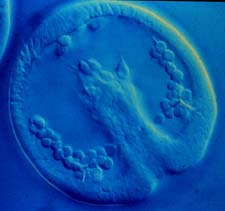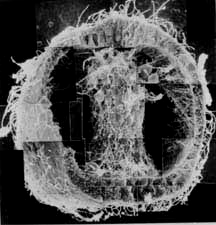








Left: A L. variegatus late gastrula viewed from the oral side (micrograph courtesy of Dr. C. Ettensohn, Carnegie-Mellon Univ). Right: A L. variegatus late gastrula processed for scanning electron microscopy (micrograph courtesy of Dr. John Morrill, Univ. of South Florida)
Secondary invagination involves the elongation of the archenteron across the blastocoel, where it attaches to the ectoderm near the animal pole of the embryo. The onset of secondary invagination correlates with the appearance of long, thin filopodia extended by secondary mesenchyme cells at the tip of the archenteron. Under a variety of circumstances, there was substantial evidence that SMCs were required for extension of the archenteron during secondary invagiantion. The next several pages explore the mechanisms of secondary invagination in some detail...